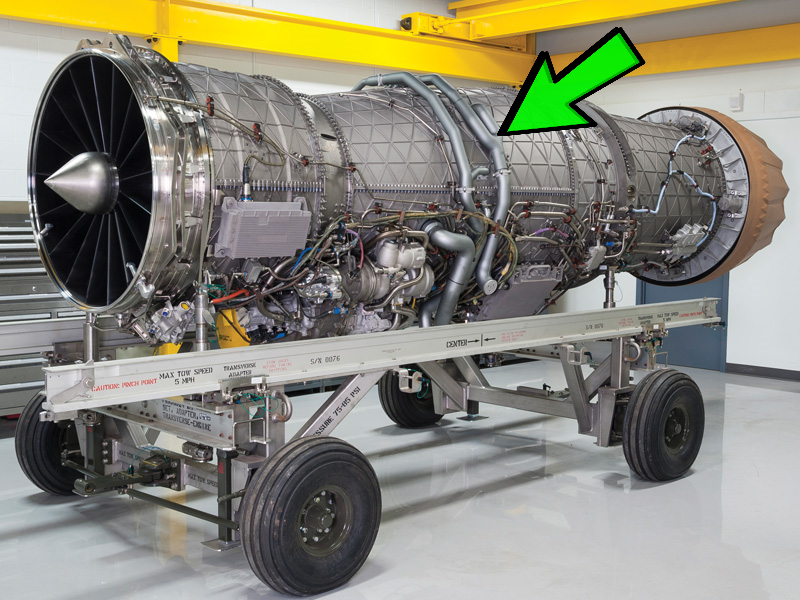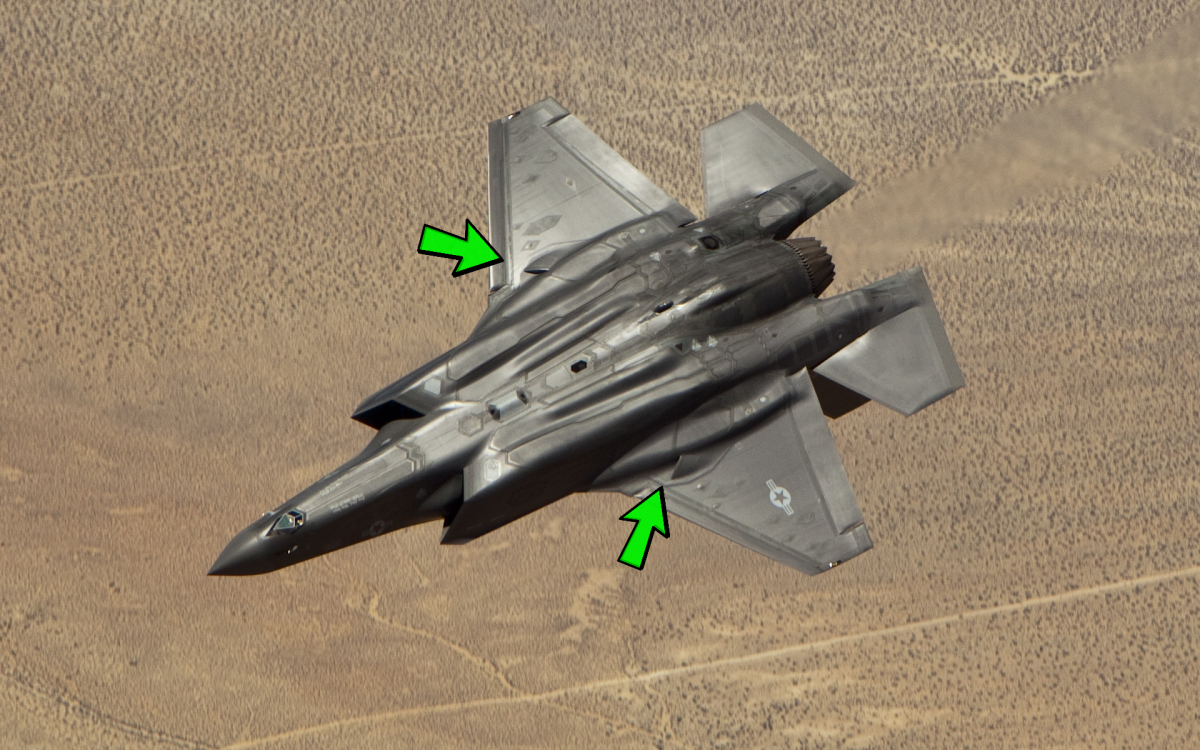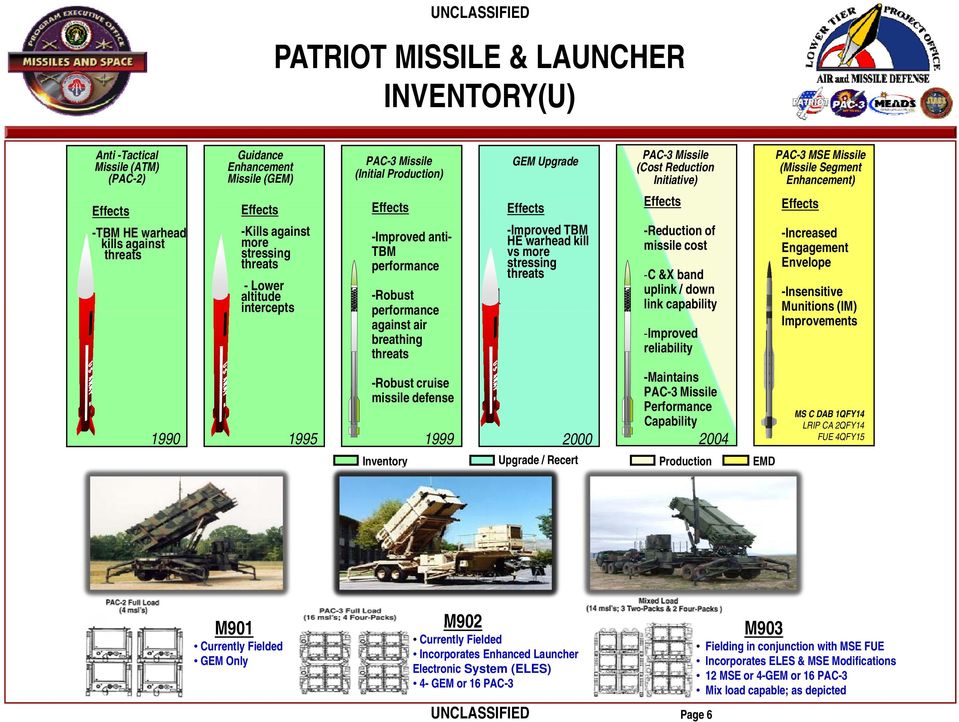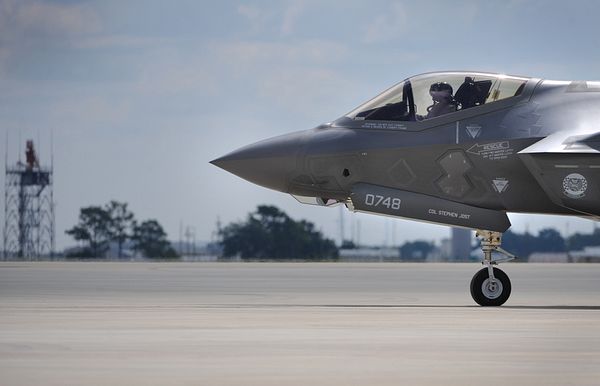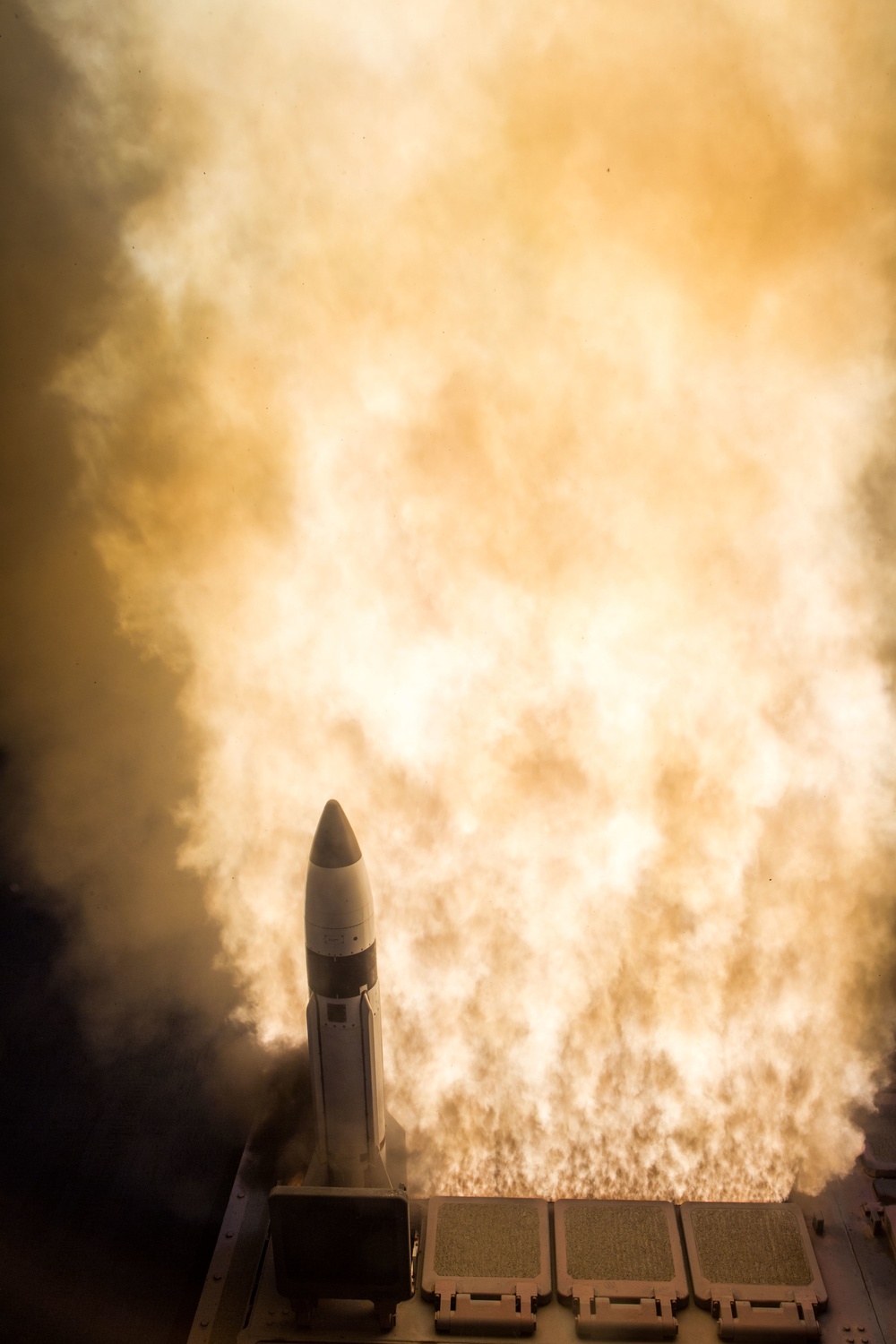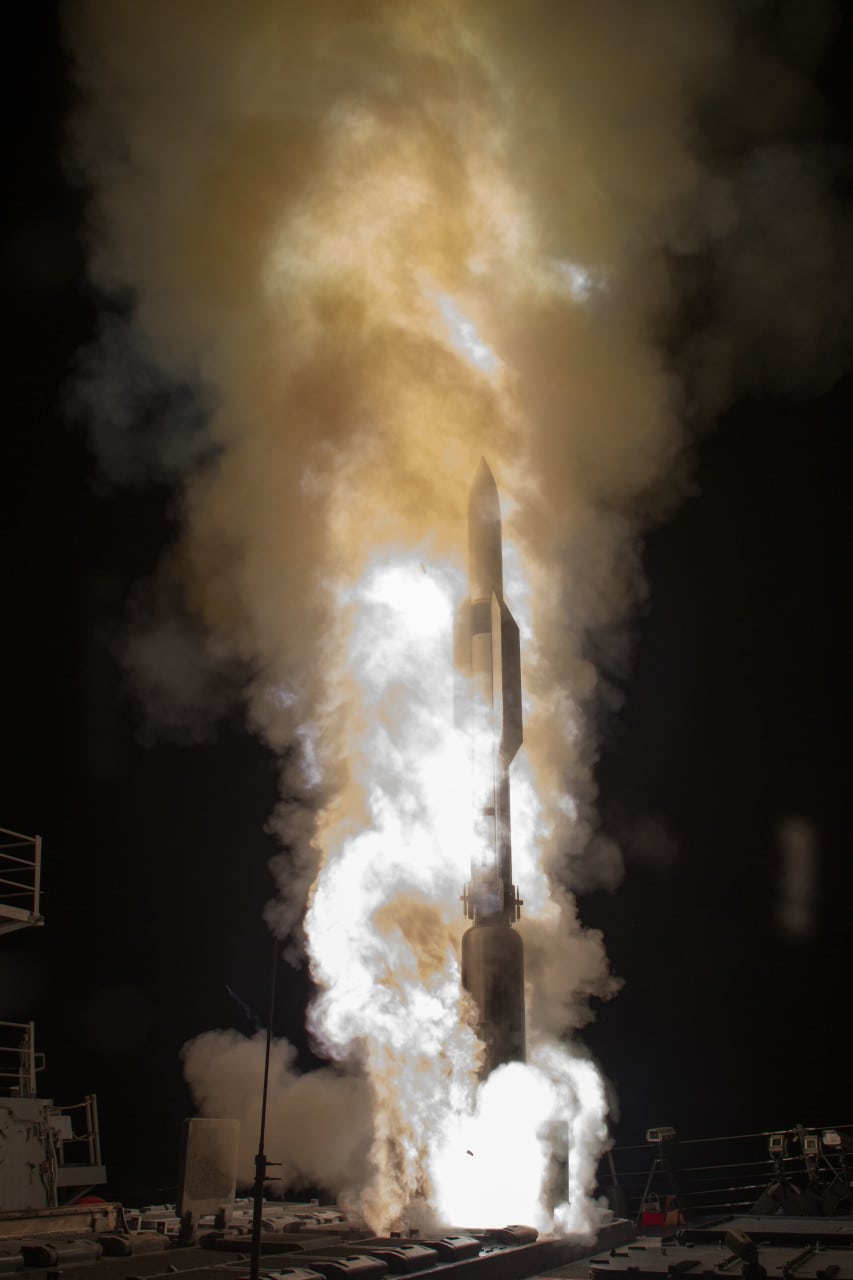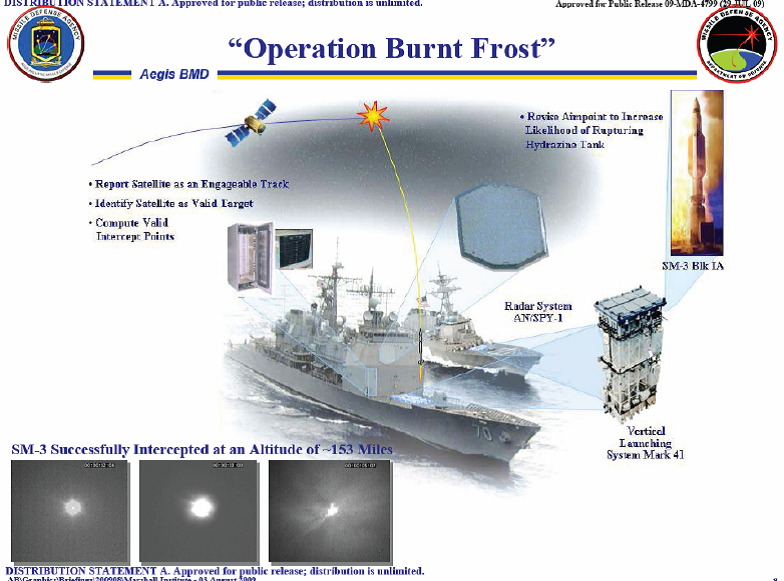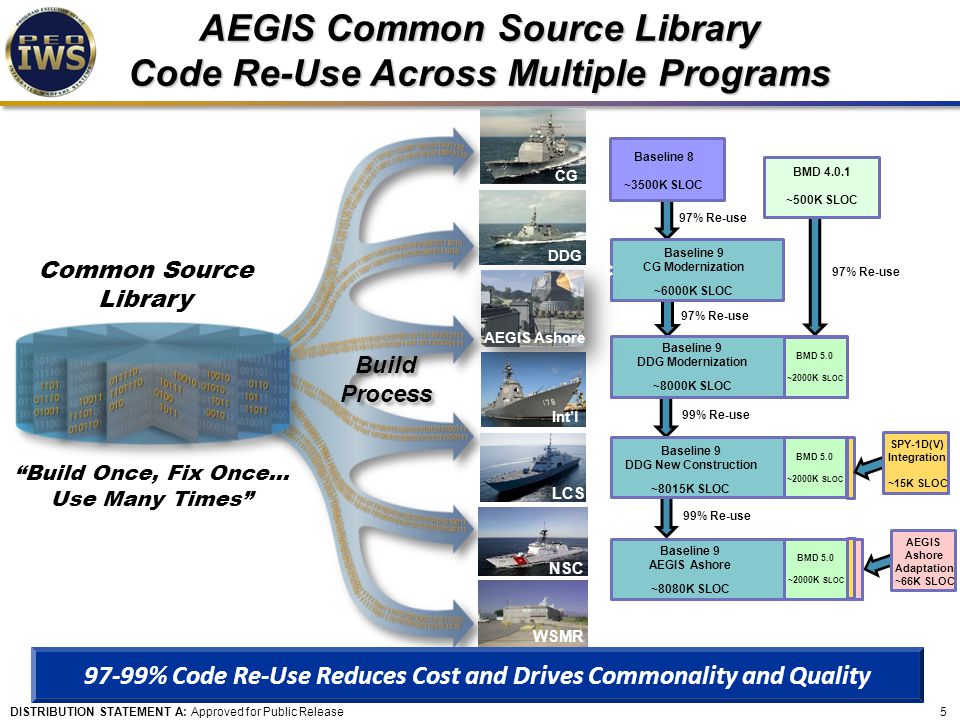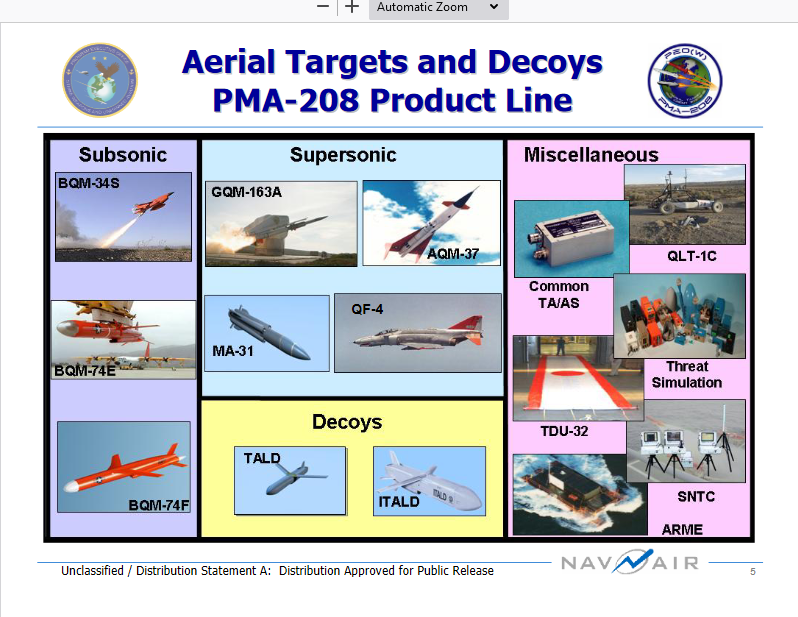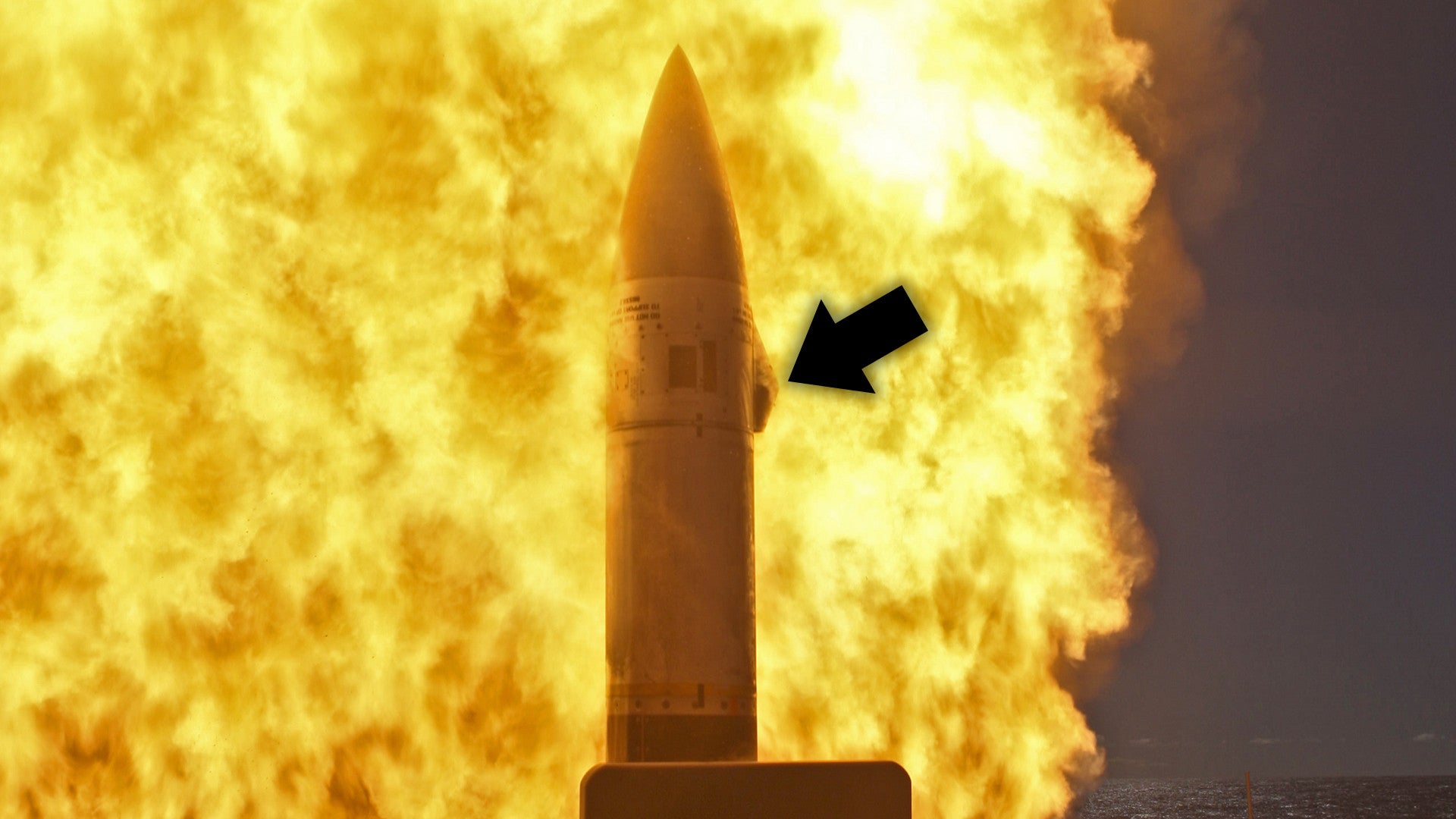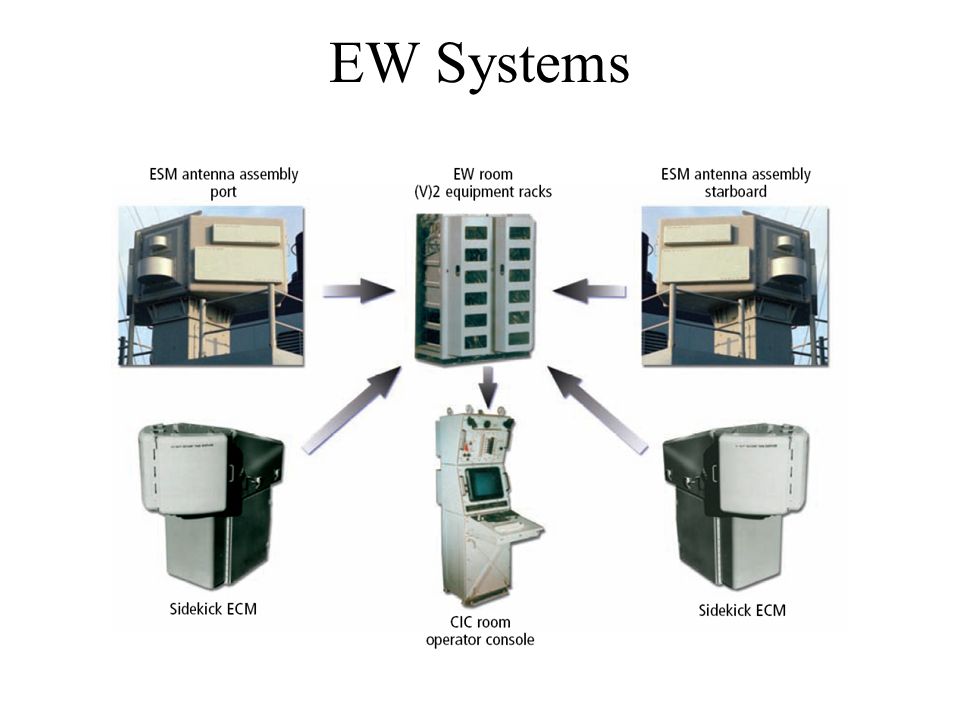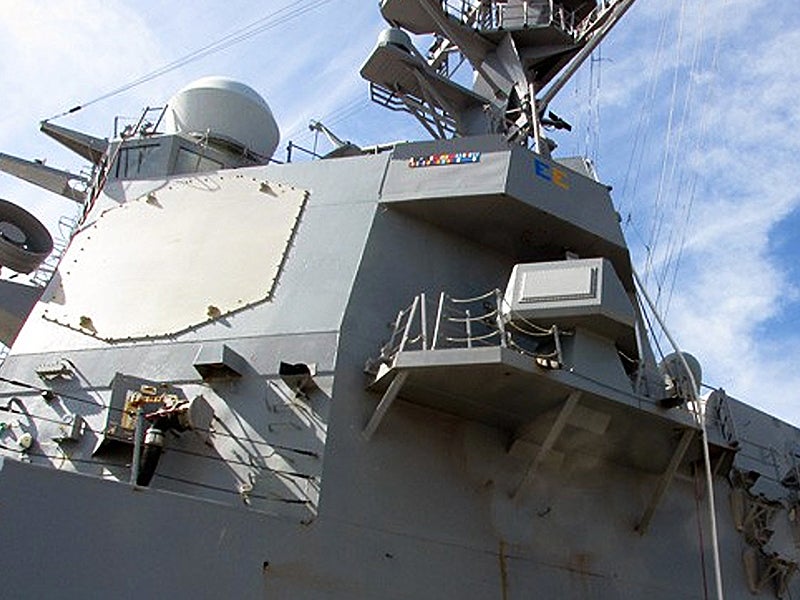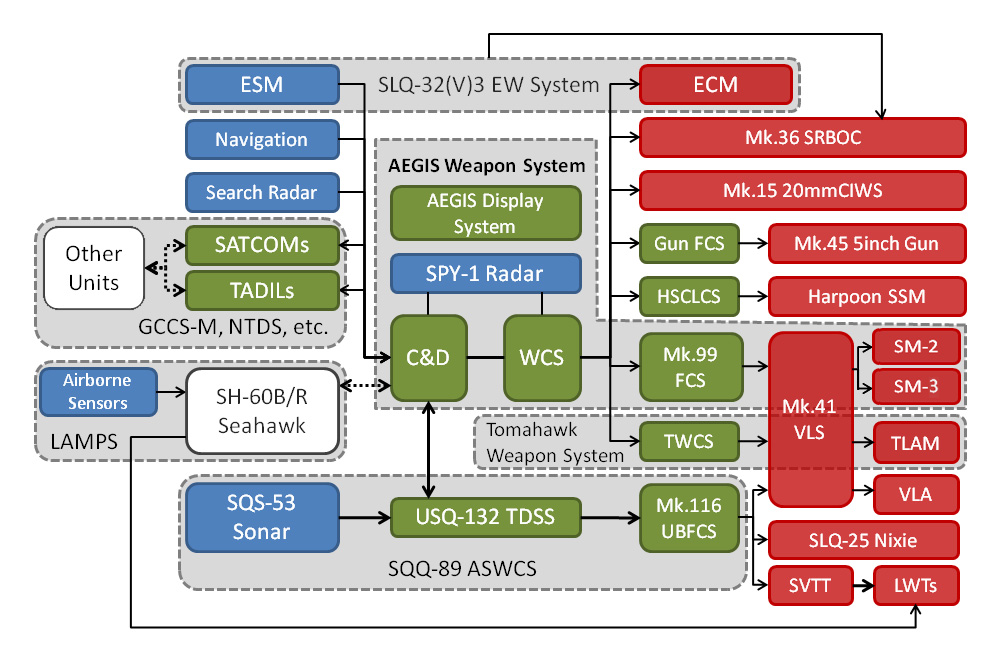F-22Raptor
ELITE MEMBER

- Joined
- Jun 19, 2014
- Messages
- 16,980
- Reaction score
- 3
- Country
- Location
Related discussion: https://defence.pk/pdf/threads/the-...ship-ballistic-missiles.684218/#post-12688458
FYI
The Navy's Secretive And Revolutionary Program To Project False Fleets From Drone Swarms
The advanced electronic warfare program uses swarms in the air and sea to cooperatively fool a wide variety of sensors dispersed over a large area.
November 7, 2019
The U.S. Navy has been quietly developing what could be one of the most important, transformative, and fascinating advances in naval combat, and warfare in general, in years. This new electronic warfare "system of systems" has been clandestinely refined over the last five years and judging from the Navy's own budgetary documents, it may be operational soon, if it isn't already. This secretive new electronic warfare "ecosystem" is known as Netted Emulation of Multi-Element Signature against Integrated Sensors, or NEMESIS.
NEMESIS is not just some 'paper program.' From publicly available, but obscure documents we've collected, it's clear that, for years, the Navy has been developing and integrating multiple types of unmanned vehicles, shipboard and submarine systems, countermeasures and electronic warfare payloads, and communication technologies to give it the ability to project what is, in essence, phantom fleets of aircraft, ships, and submarines. These realistic-looking false signatures and decoys have the ability to appear seamlessly across disparate and geographically separated enemy sensor systems located both above and below the ocean's surface. As a result, this networked and cooperative electronic warfare concept brings an unprecedented level of guileful fidelity to the fight. It's not just about disrupting the enemy's capabilities or confusing them at a command and control level, but also about making their sensors tell them the same falsehoods across large swathes of the battlespace.
Another way of looking at it is NEMESIS shifts from traditional electronic warfare tactics, in which multiple electronic warfare systems execute individual electronic attacks on multiple enemy sensors to achieve largely individual or localized effects, to a very diverse set of networked electronic warfare systems cooperatively making electronic attacks on huge portions of an enemy's sensor network. That network may stretch across large distances and multiple warfighting domains. In doing so, it achieves a cohesive set of far more unified, powerful, and convincing effects.
It sounds like science fiction, but it is anything but—it's the next quantum leap in the quiet, but ferocious struggle to control the invisible domain of electronic warfare.
The Invisible War
Electronic warfare (EW) has become an essential part of military strategy over the better part of the last century. This has only become more pronounced in recent decades as military systems have increasingly migrated into the digital age.
NATO's simplest definition of electronic warfare is as follows:
The purpose of EW is to deny the opponent the advantage of, and ensure friendly unimpeded access to the electromagnetic spectrum. EW can be applied from air, sea, land, and space, and target communication and radar systems. It involves the use of electromagnetic energy to provide improved understanding of the operational environment as well as to achieve specific effects on the modern battlefield.
Electronic warfare encompasses a huge variety of operations and tactics, such as disrupting enemy communications and preventing your own from being disrupted. Maybe the most well-known form of EW has to do with jamming enemy radar systems, but there are many forms of electronic warfare that don't involve traditional jamming. These include detecting, spoofing, and distracting enemy sensor systems and denying them the opportunity to successfully target friendly forces to varying degrees.
Cyberwarfare tactics and the ability to actually disrupt enemy sensors, networks, and command and control systems at the software level are a highly critical emerging realm of warfare that in some cases can cross over and become blended with electronic warfare tactics. Even the use of directed energy weapons can be part of a force's electronic warfare bag of tricks.
Although it is the least visible component of a present-day military's order of battle and overall capabilities, and much of the details of exactly what capabilities exist and how they are realized remains in the shadows, electronic warfare is becoming one of the most important facets of modern warfare. As a result, future combat will occur just as much in this invisible spectrum as the visible one.
The Cold War Gave Birth To Modern Electronic Warfare
Electronic warfare, as we understand it today, is not new. The U.S. military has been deploying EW technologies that go beyond simple jamming since at least the mid-20th Century. Stealth technology would never have been so successful without electronic warfare backstopping it during combat operations. In fact, the only engagement in which an F-117 was ever shot down occurred on the only night of the aircraft's use during Operation Allied Force when electronic warfare support was not available.
EW, at least how we understand it in modern, advanced terms, dates back much farther, to the height of the Cold War when the CIA launched the PALLADIUM project, which deployed radar spoofing systems and submarine-launched balloons carrying metallic radar reflectors in order to stimulate and probe Cuba's Soviet-made air defenses. The effort was part of a grander objective to understand how vulnerable the A-12 Oxcart—the CIA's progenitor of the SR-71 Blackbird and the first aircraft to integrate stealthy attributes as a driving factor in its design—would be to enemy air defenses. You can read all about this fascinating bit of history in this past piece of ours.
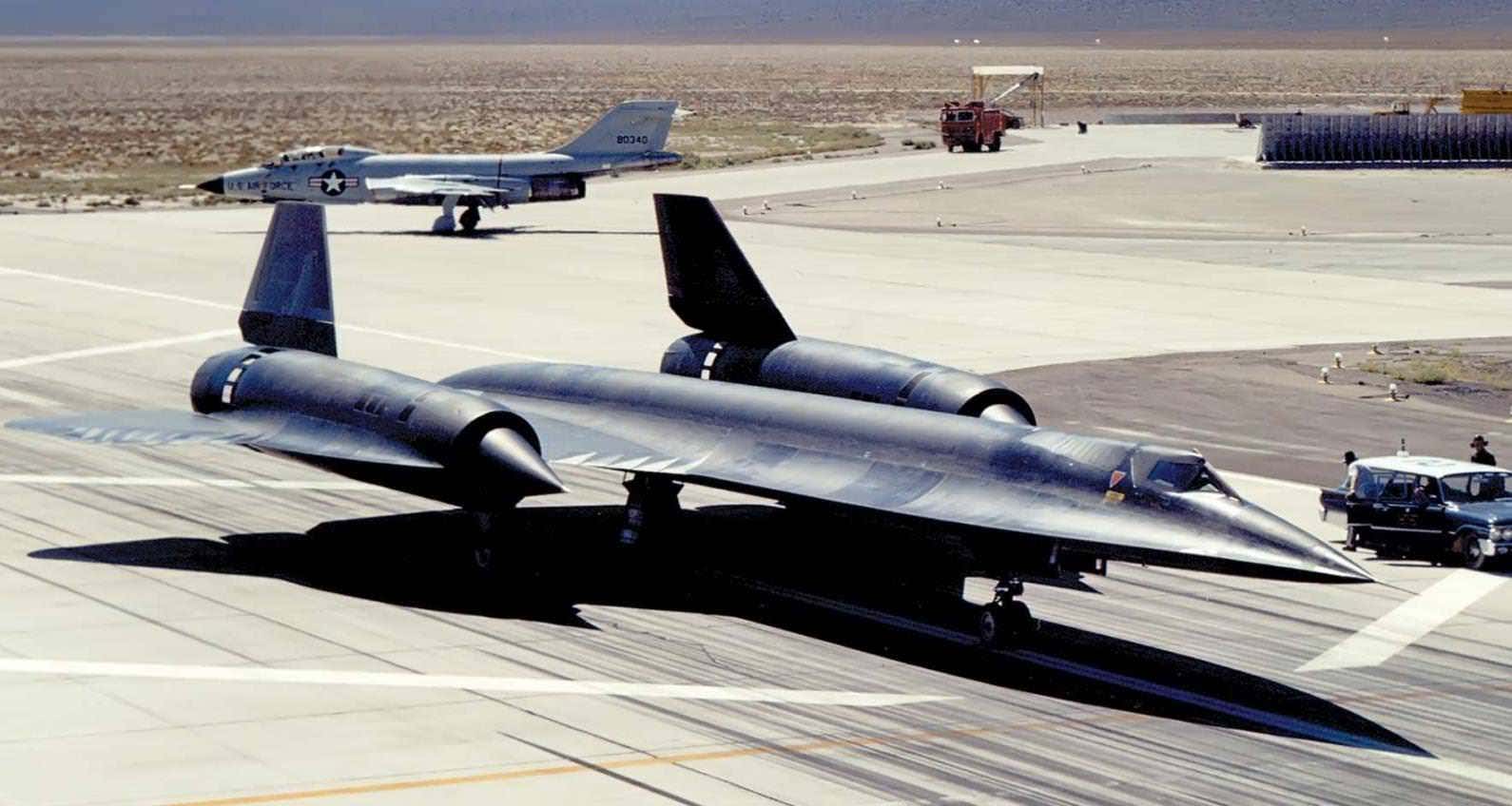
An A-12 Oxcart.
Considering that the CIA possessed the capability 65 years ago to clandestinely launch airborne radar reflectors from submarines and combine them with electronic warfare capabilities that could simulate or spoof the presence of American fighter aircraft on the most advanced Soviet radar systems of the era, it isn't hard to use one's imagination to ponder what is possible today. We know that EW capabilities have evolved drastically in step with advances in sensor, emitter, and computer processing technologies and the increasingly potent data networks that integrate and fuse their capabilities with other systems and platforms. NEMESIS is the next evolutionary leap in this regard, and a particularly huge one at that.
Electrons Not Bombs
The U.S. Navy's leadership has stated repeatedly that developing a major leap in EW capabilities has been a vital area of research over the last decade. On Oct. 29, 2013, then-Chief of Naval Operations (CNO) Admiral Jonathan Greenert, the service's top officer, said as much when he spoke at a convention of the Association of Old Crows (AOC).
At the conference, Greenert told attendees that the Navy was looking for ways to move away from traditional weaponry and turn instead more heavily towards electronic warfare and information warfare. “We've got to evolve this paradigm,” he said, adding that electronic warfare could essentially replace kinetic warfare in many situations:
"We're using the electromagnetic spectrum as a domain and as a means, and we understand and grasp it. We have to figure out how we can beat things electronically first. Why do we spend all this money kinetically if we can jam, spoof, or do otherwise? We need to prepare the fleet to enact an electronic warfare plan the same way they think of a communications or surface warfare plan."
In 2015, the National Interest published an op-ed titled “Winning the Airwaves: Sustaining America's Advantage in the Electromagnetic Spectrum,” in which authors Bryan Clark and Mark Gunzinger wrote that America had failed to maintain its electromagnetic spectrum (EMS) superiority since the end of the Cold War. This failure had allowed “China, Russia and other rivals with an opportunity to field systems that target vulnerabilities in sensor and communication networks the U.S. military has come to depend on. As a result, America’s once significant military advantage in the EMS is eroding, and may in fact no longer exist,” they said.
The same authors produced a 2015 white paper for the Center for Strategic and Budgetary Assessments (CSBA) think tank detailing how America could regain EMS superiority, writing that the Department of Defense “now has the opportunity to develop new operational concepts and technologies that will allow it to 'leap ahead' of its competitors and create enduring advantages in EMS warfare.” The document lists NEMESIS as one such technology, but does not disclose any further details about the program.
Two years earlier, however, budget documents show that the Navy was beginning to develop a highly integrated constellation of next-generation systems for spoofing or fooling distributed sensors and the platforms that host them.
NEMESIS Genesis
An electronic warfare development program known as Netted Emulation of Multi-Element Signature against Integrated Sensors or “NEMESIS” first emerged in Navy Research, Development, Test & Evaluation Budget Item Justification documents in the service's budget proposal for the 2014 Fiscal Year, which it published in April 2013. In that and subsequent budget requests, NEMSIS appeared under the program elements “PE 0602271N / Electromagnetic Systems Applied Research” and “PE 0603271N / Electromagnetic Systems Advanced Technology.”
In these budget documents, the Navy describes NEMESIS as a “System of Systems (SoS) able to coordinate distributed EW resources against many adversary surveillance and targeting sensors simultaneously” which “will benefit the warfighter by providing platform protection across the battlespace against many sensors, creating seamless cross-domain countermeasure coordination, and enabling rapid advanced technology/capability insertion to counter emerging threats.”
More specifically, the Fiscal Year 2014 Electromagnetic Systems Applied Research RDT&E Budget Item Justification states that NEMESIS “addresses the need to generate the appearance of a realistic naval force to multiple adversarial surveillance and targeting sensors simultaneously.”
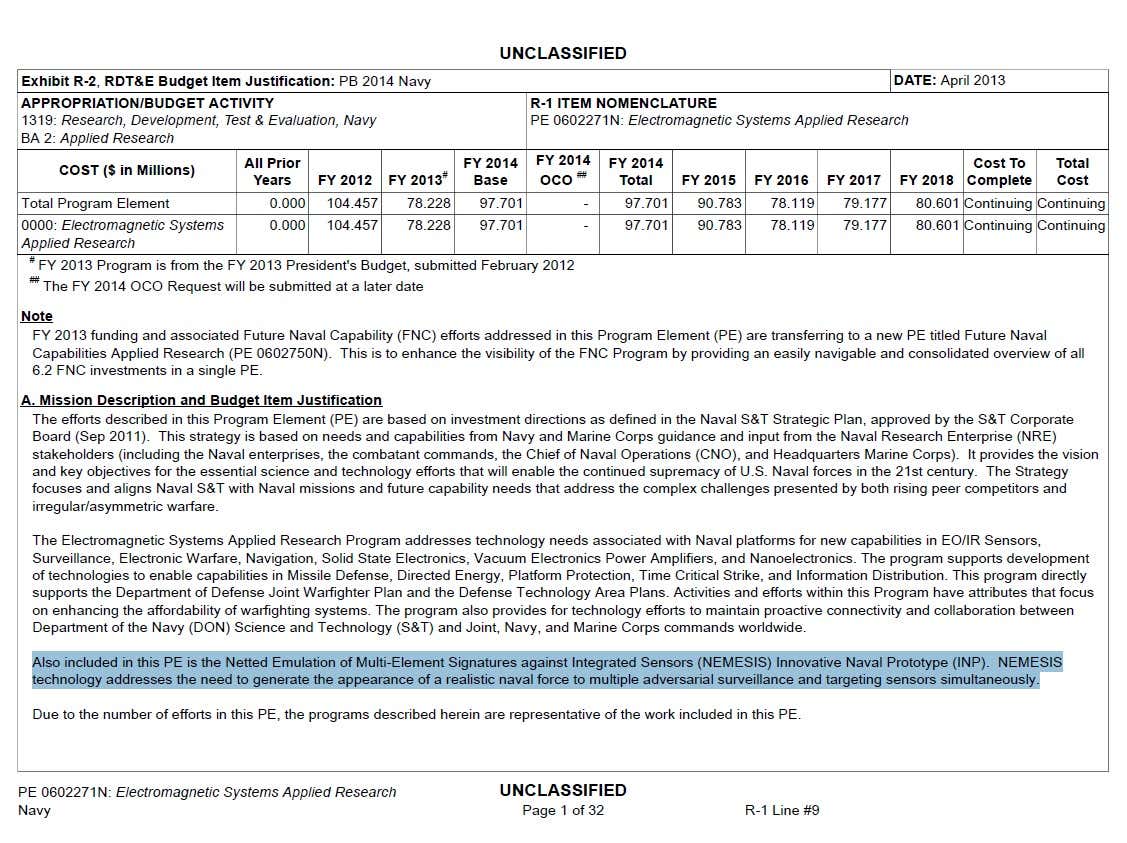
Later in that same document, a more detailed description of the program states that NEMESIS consists of “reconfigurable and modular EW payloads, Distributed Decoy and Jammer Swarms (DDJS), effective acoustic countermeasures (CM), and Multiple Input/Multiple Output Sensor/CM (MIMO S/CM) for false force generation to both above and below water sensors.”
The 2018 and 2019 budget justifications state that "Nemesis expendable decoys and prototype system hardware will be completed and delivered for field testing" and that demonstrations of these expendable decoys "will be conducted during fleet experimentation, as well as during focused field and laboratory tests."

A Shadowy NEMESIS
There is little publicly available information surrounding NEMESIS aside from these unclassified budgetary documents and a few publications and presentations that mention the program, usually to a very limited degree. Many specifics about the NEMESIS system remain unknown, but the documents help add context to the budget line item justifications we've presented above.
On April 9, 2014, Bob Smith, Director of Disruptive Technologies at the Office of Naval Research (ONR) gave a presentation at the National Defense Industrial Association’s 15th Annual Science and Engineering Technology Conference that described several innovative Navy prototype research programs, or INPs. A slide from the presentation offered a basic, but absolutely impressive overview of the NEMESIS program while of course stating “Additional details classified.”
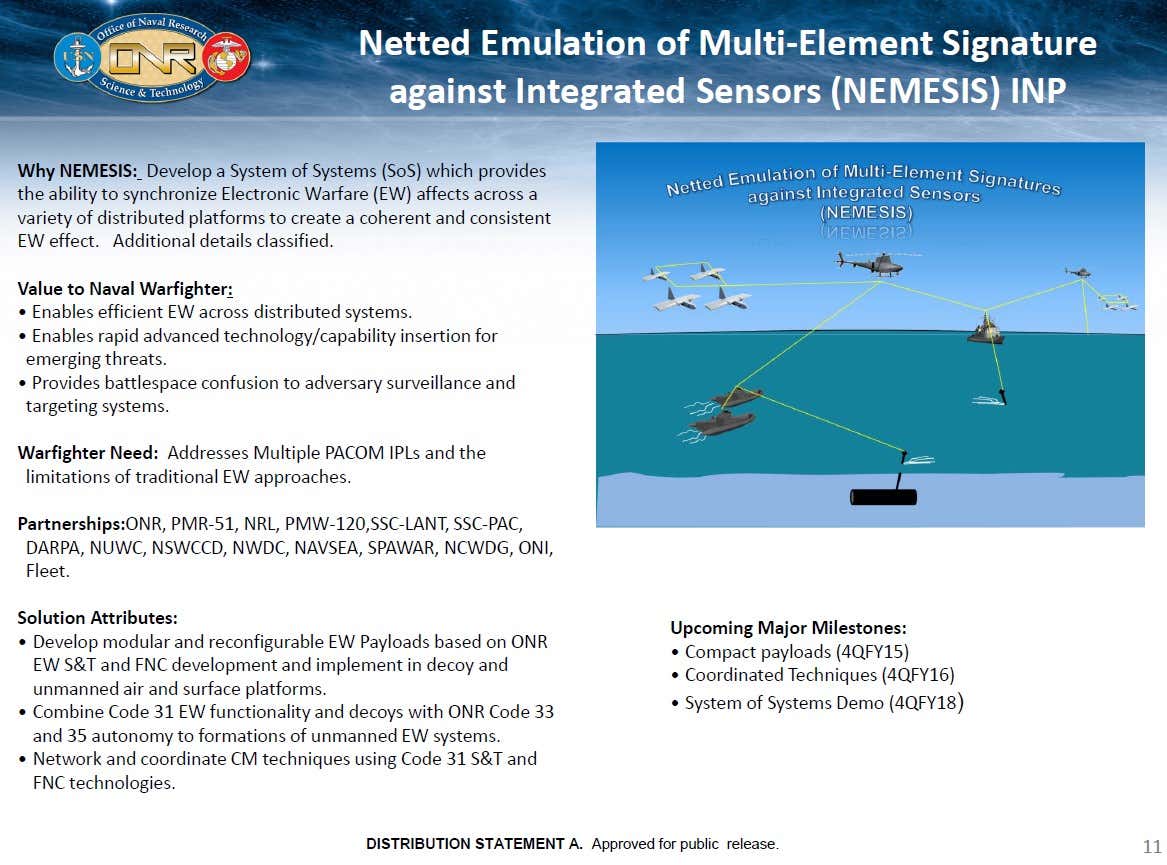
The presentation stated that NEMESIS worked against distributed sensor systems in order to confuse or spoof an enemy force's surveillance and targeting systems. That document also said that the NEMESIS system “enables rapid advanced technology/capability insertion for emerging threats”, meaning that NEMESIS could be quickly modified and upgraded to counter the latest capabilities that are still under development.
At the time, ONR said that NEMESIS addressed current limitations of traditional EW systems and multiple items on the United States Pacific Command (PACOM) Integrated Priority List (IPL), a list of the Pacific Command's highest priorities for ensuring its forces are capable of accomplishing their missions.
According to the same ONR presentation, NEMESIS consisted of "modular and reconfigurable EW payloads" including "decoy and unmanned air and surface platforms" based on the ONR's Science & Technology and Future Naval Capabilities programs. NEMESIS combined functionality and capabilities from Code 31: Information, Cyber and Spectrum Superiority; Code 33: Mission Capable, Persistent and Survivable Naval Platforms; and Code 35: Aviation, Force Projection and Integrated Defense.
Shortly after that ONR presentation, the publicly available 2015 Navy Program Guide offered a definition of NEMESIS in its appendix, stating that NEMESIS could “synchronize electronic warfare (EW) affects across a variety of distributed platforms to create coherent and consistent EW effects" and that "NEMESIS emphasis is on the coordination and synchronization of EW capabilities and tactics against sensors in many scenarios.”
That same guide also stated that development of NEMESIS began in 2014 and was an interdisciplinary project involving well-known research centers, such as the Defense Advanced Research Projects Agency (DARPA) and ONR:
In 2013 the Navy approved NEMESIS as a FY 2014 INP New Start. Initial NEMESIS activity involved planning discussions among the Office of Naval Research, the Office of the Chief of Naval Operations, fleet commands and analysts, acquisition programs of record, government laboratories and warfare centers, the Defense Advanced Research Programs Agency, and federally funded research and development centers and university affiliated research centers.
To ensure NEMESIS is addressing current and future threats to naval battle group operations, threat assessments were initiated with the Intelligence Community, and a Navy Warfare Development Command NEMESIS war game will be conducted in 2015.

On Feb. 4, 2015, Dr. Thomas Killion, then-Director of Technology at the Office of Naval Research, gave a presentation at the ONR Naval Future Force Science and Technology Expo. In that presentation, NEMESIS is listed as a current Innovative Naval Prototype (INP) program alongside some of the Navy's most important leading-edge weapons development initiatives, including the Electromagnetic Railgun, the Large Displacement Unmanned Underwater Vehicle, the Integrated Topside information operations and communications suite, and the Autonomous Aerial Cargo Unmanned System.

The Navy’s 2015 Program Guide also mentions that the Navy conducted a war game in 2015 to test the NEMESIS system. Another budget document, the 2017 RDT&E Project Justification document for the Navy's "Space and Electronic Warfare (SEW) Architecture/Engineering Support" program, states that this war game took place in late February 2015:
NEMESIS War Game: This Office of Naval Research (ONR) sponsored war game was conducted by NWDC and completed 23-26 Feb 2015. The primary purpose of the war game was to obtain fleet stakeholder input into the requirements for and design of a classified ONR Innovative Naval Prototype. The results of this effort will be used to design prototypes that could eventually be fielded as a Navy program of record.
That document also states that the NEMESIS war game which took place in 2015 "consisted of multiple events designed to explore innovative concepts and technologies associated with EMW", or electromagnetic warfare, and "obtain fleet stakeholder input into the requirements for and design of a classified ONR Innovative Naval Prototype." The descriptions of this war game appear to describe a seminar or "tabletop" exercise designed to formulate initial ideas for developing such a system, but exact details of the war game remain unknown.
The 2017 Navy Program Guide states that dedicated hardware for NEMESIS was developed in 2016 and that NEMESIS was expected to be demonstrated at full capability in late 2018:
NEMESIS has been in development since 2014, including close collaboration with the Office of Naval Research, the Office of the Chief of Naval Operations, fleet commands and analysts, acquisition programs of record, government laboratories and warfare centers, the Defense Advanced Research Programs Agency, and federally funded research and development centers and university-affiliated research centers. During 2016, NEMESIS capabilities began hardware development, technique and software migration and field testing at the sub-system level. In FY 2017-2018 flight and at-sea testing will be conducted on integrated system level capabilities in preparation for graduation demonstrations in late FY 2018.
The guide goes on to list the NEMESIS system’s developers: Georgia Tech Research Institute, Johns Hopkins' Applied Physics Lab, Massachusetts Institute of Technology's (MIT) Lincoln Lab, the Naval Undersea Warfare Center, the Office of Naval Research, and the Space and Naval Warfare Systems Command. The Navy just recently rebranded Space and Naval Warfare Systems Command as the Naval Information Warfare Systems Command.
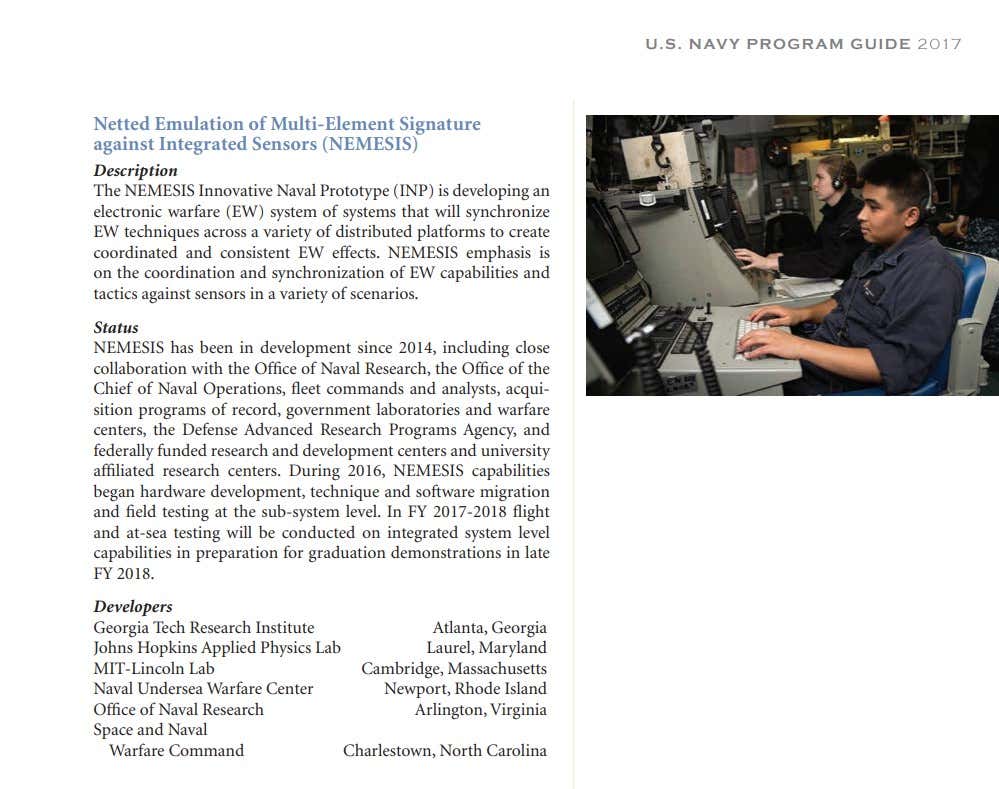
EW Swarms
While the exact components of the NEMESIS system remain unknown, there are some hints about what types of decoys and swarms could make up such a system. In a 2017 Center for Strategic and Budgetary Assessments (CSBA) white paper titled “Winning in the Gray Zone: Using Electromagnetic Warfare to Regain Escalation Dominance," authors Bryan Clark, Mark Gunzinger, and Jesse Sloman described the various elements that made up EW ecosystems then in development, such as NEMESIS and DARPA's System of System Integration Technology and Experimentation (SoSITE).
The document described swarms of expendable unmanned aerial systems that “incorporate cognitive processing and coordinate their actions through communication networks,” meaning they can share data in real-time and operate semi-autonomously to jam an adversary’s sensors, act as or release decoys, gather targeting information, and detect and map air defense networks.
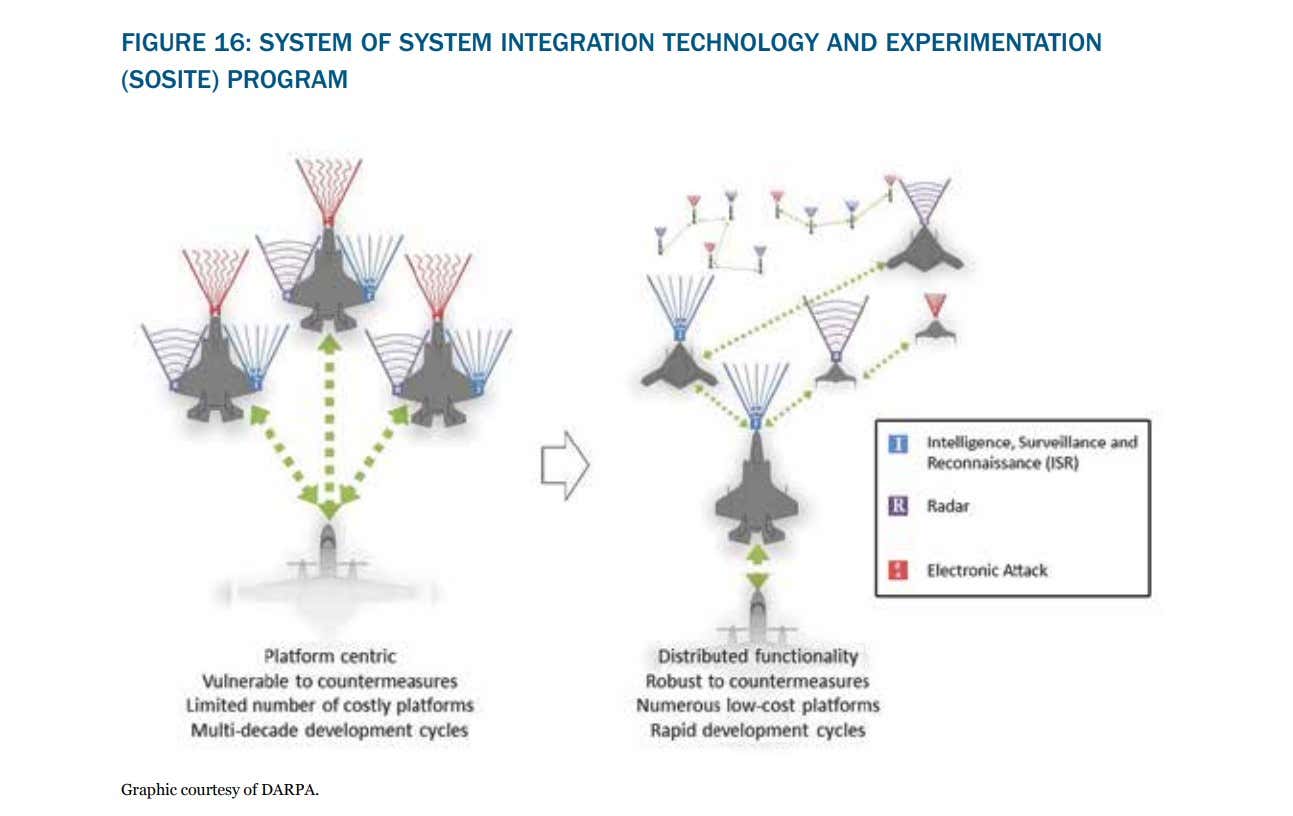
A DARPA SoSITE concept graphic of networked expendables, showing what appear to be small unmanned systems similar to the Nomad rotor-propelled drone, larger unmanned combat air vehicles reminiscent of the Northrop Grumman X-47B, and another unknown small UAV flying in concert with an F-35 Joint Strike Fighter and an E-2 Hawkeye.
Launching waves of these UAVs could extend U.S. forces’ sensor networks, confuse or obscure enemy defenses, provide a resilient communications network, coordinate and assign targets for weapons salvos, and even “provide targets to hypersonic weapons that have a very short time-of-flight," the paper explained.
Aside from providing fire and communications support, the NEMESIS system was said to be capable of creating viable false targets that would "increase the number of potential targets" an adversary would have to engage. These false targets would "mimic the RF emissions and radar returns of real platforms" and include infrared decoys and "concepts and capabilities to simulate the computer network activity of deployed forces." The NEMESIS system even included underwater "high-fidelity acoustic decoys" which can generate "additional targets for the enemy to investigate or attack," according to the CSBA white paper. These acoustic decoys could include radio emulators and simulate propeller noise or other propulsion systems, as well as specific equipment on surface ships and submarines.
The CSBA said these decoys could increase the size of the forces or amount of munitions an enemy force would have to respond with, ideally making that adversary less willing to risk a larger use of its assets. What that means is that this EW system can not only disrupt an adversary's tactics, but to some extent also dictate his battlefield decision-making.
The CSBA report described how these effects could be achieved using small unmanned EW systems launched from either high altitude balloons or undersea platforms, such as submarines or unmanned underwater vehicles (UUVs) to create these electronic warfare effects:
Launching EMW expendables at higher altitudes is another approach to extending their ranges and endurance. Launching small EMW UAVs, missiles, or munitions from very high altitude (60,000 to 120,000 feet) balloons could be a less expensive option than using a missile. High altitude balloon technologies are very mature and may cost significantly less than other delivery methods. Furthermore, defeating balloon-delivered EMW expendables would likely require SAMs that can reach very high altitudes. Using these expensive SAMs to defeat large numbers of balloons—some which might be decoys—could be costly and operationally impractical for aggressors.
Another innovative delivery method for EMW expendables could be from undersea platforms, which may be the best use of undersea payload capacity in general. [...] Undersea platforms could be one of the most effective methods to deliver EMW expendables because they can closely approach enemy coastlines and targets. This allows shorter-range expendables to be employed, which are less expensive, smaller, and can be carried in higher numbers than larger payloads like cruise missiles.
Numerous sea and submarine-launched UAVs and autonomous swarm systems have already been developed or are in development. Small drone swarms can also be launched from virtually any type of ship and from shore, and even aircraft, as well. In fact, the Navy already has a swarming electronic warfare capability in the form of the ever-evolving Miniature Air Launched Decoy (MALD). But pairing various platforms, from radar reflector and electronic warfare payload-carrying balloons and swarms of drones of different sizes and performance capabilities, and networking them together to work cooperatively to confuse, spoof, and/or blind enemy sensors dispersed over a wide area is clearly what this system is all about.
The Office of Naval Research has been testing a small, low-cost rotary-wing drone known as Nomad, described as “a highly affordable expendable design” that can be deployed without the need to ensure it returns to its parent vessel. The Nomad can be launched from tubes using a CO2 ejection system that can fit on a variety of platforms and tests of this compact UAV have found that “multiple Nomads can safely operate in the same airspace and fly in a coordinated fashion.”

Nomad undergoing testing.
One of the only non-Navy mentions of the NEMESIS program found online is in a NavalDrones.com article from 2017, which describes the Nomad specifically as being part of the NEMESIS system. While that claim is unconfirmed on an official level, the Naval Research Laboratory has publicly disclosed tests of the Nomad system without mentioning NEMESIS. Still, given that many of the NEMESIS documents state that “Distributed Decoy and Jammer Swarms (DDJS)” are an integral part of the system, it’s possible, if not probable, that Nomad and swarms of other small drones are part of this highly sophisticated and networked electronic warfare capability.
The 2017 CSBA paper also cites a wide range of other unmanned systems that could hypothetically be integrated into the NEMESIS system, although it remains unknown which specific expendables are used:
Small expendables in development or use today include the Switchblade precision missile, which is in use with Special Operations Forces; small UAVs such as the Coyote UAV, used in the Navy’s Low-Cost UAV Swarming Technology (LOCUST) program; and loitering munitions like the Lockheed Martin Fire Shadow. Expendables have also been integrated with launch platforms. The Navy is developing a submarine-launched version of the Blackwing UAV, which is similar to the Switchblade. Furthermore, the U.S. Air Force has deployed the Miniature Air-Launched Decoy (MALD) since the 1990s.
The aforementioned LOCUST would be one of the most obvious platforms to execute major parts of the NEMESIS concept. The Navy has been experimenting with this highly deployable swarming drone capability for years and the airframes are highly adaptable and can be launched from almost anywhere.
Lockheed Martin has been also developing small unmanned aerial vehicles such as the tiny Outrider micro-aircraft, which can be launched from canisters that fit inside submarine missile tubes. The Naval Research Laboratory has tested all-electric folding wing drones designed to launch from torpedo tubes using existing launch systems. Glimpses of other similar systems in development have been offered over the last few years, including ones designed to carry infrared and electro-optical payloads.
Northrop Grumman has tested electronic warfare drones dropped from EA-18G Growlers inside canister deployment systems and air-launched electronic warfare enabled swarming munitions are set to become a major staple of aerial warfare.
Earlier this year, the Office of Naval Research issued a special notice for a research opportunity to develop a “Long Endurance Advanced Off-board Electronic Warfare Platform,” or LEAP. This program was listed under two of the same codes as NEMESIS, ONR Code 35: Aerodynamics, Autonomy, Flight Dynamics & Control, as well as Code 31: Electronic Warfare. The proposed vehicle design to be researched was for a ship-launched, long-range expendable decoy that can carry modular EW payloads.
Swarms of small unmanned surface vessels and even undersea vessels seem to fulfill aspects of NEMESIS' cross-domain capability as well. But leveraging swarms of smaller and somewhat expendable aerial drones and munitions that can work in conjunction with larger, less numerous, and more advanced platforms allows the NEMESIS concept to cover large geographical areas associated with modern naval combat and to distribute EW capabilities in a more resilient and decentralized manner than in the past. In doing so, it also allows for these swarms and the various dissimilar nodes that can make up the NEMESIS system at any given time to create fleets of ships and aircraft that aren't really there across a huge area as well as execute more mundane tasks, such as jamming individual enemy emitters or working as sacrificial decoys for enemy weapons themselves.
All of this could, and eventually will, also be networked with existing, more traditional electronic warfare systems such as those mounted on the Navy's surface combatants. In particular, this could be networked with the SLQ-32 SEWIP and the new and shadowy SLQ-59 that has recently arrived on some of the Navy's vessels. The Navy's EA-18G Growler could also act as a major component in this EW ecosystem and as a forward command and control node.
It's also worth remembering that NEMESIS, or at least parts of it, would also be an incredible and obvious intelligence collecting tool when it comes to probing and evaluating an enemy's defenses and recording its electronic order of battle. This could be done even in peacetime, very much in the same vein of PALLADIUM so many years ago, but on a much larger and more elaborate scale.
Evolution Of A Revolution
In Fiscal Year 2015, the NEMESIS program expanded beyond the Navy’s PE 0602271N / Electromagnetic Systems Applied Research program and began appearing in the budget line justification documents of several additional programs in subsequent fiscal years. During the next fiscal cycle, the Navy’s Electromagnetic Systems Applied Research program continued to work on NEMESIS as it had in prior years. Then, in Fiscal Year 2017, the program’s budget increased significantly “due to hardware procurement and conducting field experiments of NEMESIS technologies.”
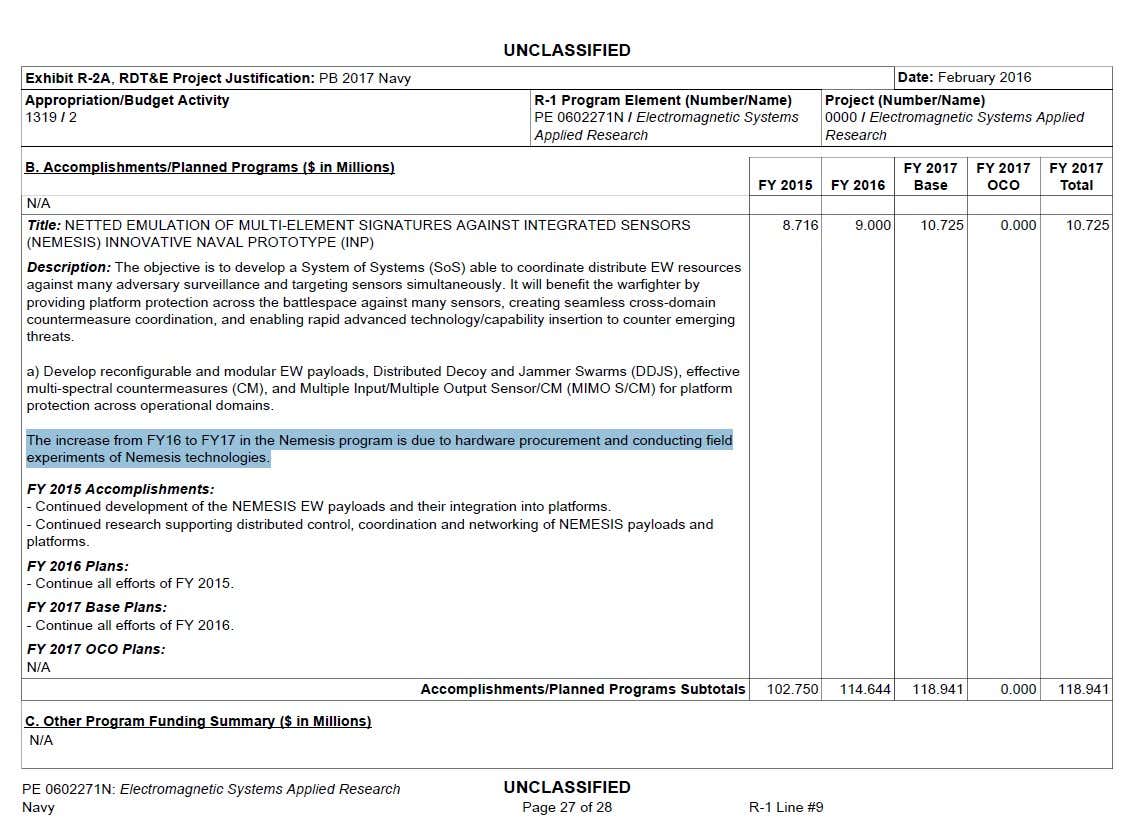
The Fiscal Year 2017 RDT&E Project Justification for the NEMESIS work conducted by Navy program PE 0603271N / Electromagnetic Systems Advanced Technology states that Fiscal Years 2017 and 2018 are dedicated to “the integration and demonstration of these new technologies”.

In Fiscal Year 2018, NEMESIS appeared on two new Navy research program elements titled “PE 0602792N / (U)Innovative Naval Prototypes(INP) Applied Research” and “PE 0603801N / (U) Innovative Naval Prototypes (INP) Advanced Technology Development.” Those programs' goals for that fiscal cycle, respectively, were:
PE 0602792N / (U)Innovative Naval Prototypes(INP) Applied Research: Complete the Nemesis project by finishing research efforts to develop and mature technologies in multiple areas that will be used to assess the feasibility of Nemesis to coordinate Electronic Warfare (EW) operations across distributed EW systems. Technologies being matured include swarming vehicle operations, distributed resource mission control, multi-domain coordinated operations and advanced RF component and subsystems technologies. These emerging technologies are being designed and developed for prototype Nemesis systems which will be capable of performing coordinated EW operations across distributed EW systems.
PE 0603801N / (U) Innovative Naval Prototypes (INP) Advanced Technology Development: Complete the Nemesis project, previously funded in 0603271N Electromagnetic Systems Advanced Technology Development, by designing and building prototype Nemesis payloads that implement industry standards for software, hardware, and firmware interfaces. Nemesis expendable decoys and prototype system hardware will be completed and delivered for field testing. Demonstrations of Nemesis platforms and payload will be conducted during fleet experimentation, as well as during focused field and laboratory tests.
These budgetary documents state that the Innovative Naval Prototype programs "represent game-changing technologies with the potential to revolutionize operational concepts. They are disruptive in nature as they would dramatically change the way naval forces fight. INPs push the imagination of our nation's technical talent to deliver transformational warfighting capabilities."

In Fiscal Year 2019, funding continued to decrease in both the PE 0603271N / Electromagnetic Systems Advanced Technology and PE 0602271N / Electromagnetic Systems Applied Research programs due to the fact that the NEMESIS program was now being developed under the Innovative Naval Prototypes programs, suggesting it has advanced beyond research and development and is now working towards an operational state.
Electronic Warfare: The Next Generation
The very existence of NEMESIS proves that a revolution in electronic warfare is well underway. If the capabilities we've described can be gleaned from scant publicly available information, there are no doubts that more advanced NEMESIS components and capabilities remain classified. It is also likely that some components of the system have existed long before they began to be integrated with other platforms under the NEMESIS program. Above all else, that is what NEMESIS does: it pulls together various leading-edge EW concepts and networks them together for a combined electronic warfare fight the likes of which we have never seen before.
As more nations develop and refine their advanced integrated sensor networks, next-generation EW "systems of systems" such as NEMESIS will become more vital to protecting the U.S. and allied assets and for giving them a leg up by being able to directly manipulate what the enemy believes is occurring on the battlespace based on their own sensors' data. As such, NEMESIS can help level the playing field against increasingly capable sensor networks, whether by blinding certain parts of those networks while spoofing others or by having the enemy fire its treasured weaponry at ghosts in the sea and in the air. Even a formation of what appears to be an incoming bomber force on radar and a puzzling group of bright signatures on infrared sensors could draw the enemy's attention away from critical parts on a real offensive.
Yes, much of this sounds almost like magic, and it is probably the closest thing the military has to it, but going by even the limited information we were able to uncover about NEMESIS, it really does represent the evolutionary next great leap in electronic warfare—one that will elevate this murky art from a supporting aspect of military operations to a primary offensive and defensive one.
LINK: https://www.thedrive.com/the-war-zo...e-capability-will-change-naval-combat-forever
China's ASBM battle concepts have already been defeated and most don't even realize it.
I just wanted to add something here. Just because we do not have photographic evidence of the DF-26 or DF-21D hitting a moving target on the sea does not mean it has not hit one on land. It is almost 100% certain the PLARF has set moving targets on land as to avoid intel collection and possibly provoking other countries. Do these jokers really think they would not test these missiles on moving targets when it is literally designed to hit moving targets? Also, there are rumors that the two launched last week did indeed strike a moving target (IIRC some decommissioned ship).
FYI
The Navy's Secretive And Revolutionary Program To Project False Fleets From Drone Swarms
The advanced electronic warfare program uses swarms in the air and sea to cooperatively fool a wide variety of sensors dispersed over a large area.
November 7, 2019
The U.S. Navy has been quietly developing what could be one of the most important, transformative, and fascinating advances in naval combat, and warfare in general, in years. This new electronic warfare "system of systems" has been clandestinely refined over the last five years and judging from the Navy's own budgetary documents, it may be operational soon, if it isn't already. This secretive new electronic warfare "ecosystem" is known as Netted Emulation of Multi-Element Signature against Integrated Sensors, or NEMESIS.
NEMESIS is not just some 'paper program.' From publicly available, but obscure documents we've collected, it's clear that, for years, the Navy has been developing and integrating multiple types of unmanned vehicles, shipboard and submarine systems, countermeasures and electronic warfare payloads, and communication technologies to give it the ability to project what is, in essence, phantom fleets of aircraft, ships, and submarines. These realistic-looking false signatures and decoys have the ability to appear seamlessly across disparate and geographically separated enemy sensor systems located both above and below the ocean's surface. As a result, this networked and cooperative electronic warfare concept brings an unprecedented level of guileful fidelity to the fight. It's not just about disrupting the enemy's capabilities or confusing them at a command and control level, but also about making their sensors tell them the same falsehoods across large swathes of the battlespace.
Another way of looking at it is NEMESIS shifts from traditional electronic warfare tactics, in which multiple electronic warfare systems execute individual electronic attacks on multiple enemy sensors to achieve largely individual or localized effects, to a very diverse set of networked electronic warfare systems cooperatively making electronic attacks on huge portions of an enemy's sensor network. That network may stretch across large distances and multiple warfighting domains. In doing so, it achieves a cohesive set of far more unified, powerful, and convincing effects.
It sounds like science fiction, but it is anything but—it's the next quantum leap in the quiet, but ferocious struggle to control the invisible domain of electronic warfare.
The Invisible War
Electronic warfare (EW) has become an essential part of military strategy over the better part of the last century. This has only become more pronounced in recent decades as military systems have increasingly migrated into the digital age.
NATO's simplest definition of electronic warfare is as follows:
The purpose of EW is to deny the opponent the advantage of, and ensure friendly unimpeded access to the electromagnetic spectrum. EW can be applied from air, sea, land, and space, and target communication and radar systems. It involves the use of electromagnetic energy to provide improved understanding of the operational environment as well as to achieve specific effects on the modern battlefield.
Electronic warfare encompasses a huge variety of operations and tactics, such as disrupting enemy communications and preventing your own from being disrupted. Maybe the most well-known form of EW has to do with jamming enemy radar systems, but there are many forms of electronic warfare that don't involve traditional jamming. These include detecting, spoofing, and distracting enemy sensor systems and denying them the opportunity to successfully target friendly forces to varying degrees.
Cyberwarfare tactics and the ability to actually disrupt enemy sensors, networks, and command and control systems at the software level are a highly critical emerging realm of warfare that in some cases can cross over and become blended with electronic warfare tactics. Even the use of directed energy weapons can be part of a force's electronic warfare bag of tricks.
Although it is the least visible component of a present-day military's order of battle and overall capabilities, and much of the details of exactly what capabilities exist and how they are realized remains in the shadows, electronic warfare is becoming one of the most important facets of modern warfare. As a result, future combat will occur just as much in this invisible spectrum as the visible one.
The Cold War Gave Birth To Modern Electronic Warfare
Electronic warfare, as we understand it today, is not new. The U.S. military has been deploying EW technologies that go beyond simple jamming since at least the mid-20th Century. Stealth technology would never have been so successful without electronic warfare backstopping it during combat operations. In fact, the only engagement in which an F-117 was ever shot down occurred on the only night of the aircraft's use during Operation Allied Force when electronic warfare support was not available.
EW, at least how we understand it in modern, advanced terms, dates back much farther, to the height of the Cold War when the CIA launched the PALLADIUM project, which deployed radar spoofing systems and submarine-launched balloons carrying metallic radar reflectors in order to stimulate and probe Cuba's Soviet-made air defenses. The effort was part of a grander objective to understand how vulnerable the A-12 Oxcart—the CIA's progenitor of the SR-71 Blackbird and the first aircraft to integrate stealthy attributes as a driving factor in its design—would be to enemy air defenses. You can read all about this fascinating bit of history in this past piece of ours.

An A-12 Oxcart.
Considering that the CIA possessed the capability 65 years ago to clandestinely launch airborne radar reflectors from submarines and combine them with electronic warfare capabilities that could simulate or spoof the presence of American fighter aircraft on the most advanced Soviet radar systems of the era, it isn't hard to use one's imagination to ponder what is possible today. We know that EW capabilities have evolved drastically in step with advances in sensor, emitter, and computer processing technologies and the increasingly potent data networks that integrate and fuse their capabilities with other systems and platforms. NEMESIS is the next evolutionary leap in this regard, and a particularly huge one at that.
Electrons Not Bombs
The U.S. Navy's leadership has stated repeatedly that developing a major leap in EW capabilities has been a vital area of research over the last decade. On Oct. 29, 2013, then-Chief of Naval Operations (CNO) Admiral Jonathan Greenert, the service's top officer, said as much when he spoke at a convention of the Association of Old Crows (AOC).
At the conference, Greenert told attendees that the Navy was looking for ways to move away from traditional weaponry and turn instead more heavily towards electronic warfare and information warfare. “We've got to evolve this paradigm,” he said, adding that electronic warfare could essentially replace kinetic warfare in many situations:
"We're using the electromagnetic spectrum as a domain and as a means, and we understand and grasp it. We have to figure out how we can beat things electronically first. Why do we spend all this money kinetically if we can jam, spoof, or do otherwise? We need to prepare the fleet to enact an electronic warfare plan the same way they think of a communications or surface warfare plan."
In 2015, the National Interest published an op-ed titled “Winning the Airwaves: Sustaining America's Advantage in the Electromagnetic Spectrum,” in which authors Bryan Clark and Mark Gunzinger wrote that America had failed to maintain its electromagnetic spectrum (EMS) superiority since the end of the Cold War. This failure had allowed “China, Russia and other rivals with an opportunity to field systems that target vulnerabilities in sensor and communication networks the U.S. military has come to depend on. As a result, America’s once significant military advantage in the EMS is eroding, and may in fact no longer exist,” they said.
The same authors produced a 2015 white paper for the Center for Strategic and Budgetary Assessments (CSBA) think tank detailing how America could regain EMS superiority, writing that the Department of Defense “now has the opportunity to develop new operational concepts and technologies that will allow it to 'leap ahead' of its competitors and create enduring advantages in EMS warfare.” The document lists NEMESIS as one such technology, but does not disclose any further details about the program.
Two years earlier, however, budget documents show that the Navy was beginning to develop a highly integrated constellation of next-generation systems for spoofing or fooling distributed sensors and the platforms that host them.
NEMESIS Genesis
An electronic warfare development program known as Netted Emulation of Multi-Element Signature against Integrated Sensors or “NEMESIS” first emerged in Navy Research, Development, Test & Evaluation Budget Item Justification documents in the service's budget proposal for the 2014 Fiscal Year, which it published in April 2013. In that and subsequent budget requests, NEMSIS appeared under the program elements “PE 0602271N / Electromagnetic Systems Applied Research” and “PE 0603271N / Electromagnetic Systems Advanced Technology.”
In these budget documents, the Navy describes NEMESIS as a “System of Systems (SoS) able to coordinate distributed EW resources against many adversary surveillance and targeting sensors simultaneously” which “will benefit the warfighter by providing platform protection across the battlespace against many sensors, creating seamless cross-domain countermeasure coordination, and enabling rapid advanced technology/capability insertion to counter emerging threats.”
More specifically, the Fiscal Year 2014 Electromagnetic Systems Applied Research RDT&E Budget Item Justification states that NEMESIS “addresses the need to generate the appearance of a realistic naval force to multiple adversarial surveillance and targeting sensors simultaneously.”

Later in that same document, a more detailed description of the program states that NEMESIS consists of “reconfigurable and modular EW payloads, Distributed Decoy and Jammer Swarms (DDJS), effective acoustic countermeasures (CM), and Multiple Input/Multiple Output Sensor/CM (MIMO S/CM) for false force generation to both above and below water sensors.”
The 2018 and 2019 budget justifications state that "Nemesis expendable decoys and prototype system hardware will be completed and delivered for field testing" and that demonstrations of these expendable decoys "will be conducted during fleet experimentation, as well as during focused field and laboratory tests."

A Shadowy NEMESIS
There is little publicly available information surrounding NEMESIS aside from these unclassified budgetary documents and a few publications and presentations that mention the program, usually to a very limited degree. Many specifics about the NEMESIS system remain unknown, but the documents help add context to the budget line item justifications we've presented above.
On April 9, 2014, Bob Smith, Director of Disruptive Technologies at the Office of Naval Research (ONR) gave a presentation at the National Defense Industrial Association’s 15th Annual Science and Engineering Technology Conference that described several innovative Navy prototype research programs, or INPs. A slide from the presentation offered a basic, but absolutely impressive overview of the NEMESIS program while of course stating “Additional details classified.”

The presentation stated that NEMESIS worked against distributed sensor systems in order to confuse or spoof an enemy force's surveillance and targeting systems. That document also said that the NEMESIS system “enables rapid advanced technology/capability insertion for emerging threats”, meaning that NEMESIS could be quickly modified and upgraded to counter the latest capabilities that are still under development.
At the time, ONR said that NEMESIS addressed current limitations of traditional EW systems and multiple items on the United States Pacific Command (PACOM) Integrated Priority List (IPL), a list of the Pacific Command's highest priorities for ensuring its forces are capable of accomplishing their missions.
According to the same ONR presentation, NEMESIS consisted of "modular and reconfigurable EW payloads" including "decoy and unmanned air and surface platforms" based on the ONR's Science & Technology and Future Naval Capabilities programs. NEMESIS combined functionality and capabilities from Code 31: Information, Cyber and Spectrum Superiority; Code 33: Mission Capable, Persistent and Survivable Naval Platforms; and Code 35: Aviation, Force Projection and Integrated Defense.
Shortly after that ONR presentation, the publicly available 2015 Navy Program Guide offered a definition of NEMESIS in its appendix, stating that NEMESIS could “synchronize electronic warfare (EW) affects across a variety of distributed platforms to create coherent and consistent EW effects" and that "NEMESIS emphasis is on the coordination and synchronization of EW capabilities and tactics against sensors in many scenarios.”
That same guide also stated that development of NEMESIS began in 2014 and was an interdisciplinary project involving well-known research centers, such as the Defense Advanced Research Projects Agency (DARPA) and ONR:
In 2013 the Navy approved NEMESIS as a FY 2014 INP New Start. Initial NEMESIS activity involved planning discussions among the Office of Naval Research, the Office of the Chief of Naval Operations, fleet commands and analysts, acquisition programs of record, government laboratories and warfare centers, the Defense Advanced Research Programs Agency, and federally funded research and development centers and university affiliated research centers.
To ensure NEMESIS is addressing current and future threats to naval battle group operations, threat assessments were initiated with the Intelligence Community, and a Navy Warfare Development Command NEMESIS war game will be conducted in 2015.

On Feb. 4, 2015, Dr. Thomas Killion, then-Director of Technology at the Office of Naval Research, gave a presentation at the ONR Naval Future Force Science and Technology Expo. In that presentation, NEMESIS is listed as a current Innovative Naval Prototype (INP) program alongside some of the Navy's most important leading-edge weapons development initiatives, including the Electromagnetic Railgun, the Large Displacement Unmanned Underwater Vehicle, the Integrated Topside information operations and communications suite, and the Autonomous Aerial Cargo Unmanned System.

The Navy’s 2015 Program Guide also mentions that the Navy conducted a war game in 2015 to test the NEMESIS system. Another budget document, the 2017 RDT&E Project Justification document for the Navy's "Space and Electronic Warfare (SEW) Architecture/Engineering Support" program, states that this war game took place in late February 2015:
NEMESIS War Game: This Office of Naval Research (ONR) sponsored war game was conducted by NWDC and completed 23-26 Feb 2015. The primary purpose of the war game was to obtain fleet stakeholder input into the requirements for and design of a classified ONR Innovative Naval Prototype. The results of this effort will be used to design prototypes that could eventually be fielded as a Navy program of record.
That document also states that the NEMESIS war game which took place in 2015 "consisted of multiple events designed to explore innovative concepts and technologies associated with EMW", or electromagnetic warfare, and "obtain fleet stakeholder input into the requirements for and design of a classified ONR Innovative Naval Prototype." The descriptions of this war game appear to describe a seminar or "tabletop" exercise designed to formulate initial ideas for developing such a system, but exact details of the war game remain unknown.
The 2017 Navy Program Guide states that dedicated hardware for NEMESIS was developed in 2016 and that NEMESIS was expected to be demonstrated at full capability in late 2018:
NEMESIS has been in development since 2014, including close collaboration with the Office of Naval Research, the Office of the Chief of Naval Operations, fleet commands and analysts, acquisition programs of record, government laboratories and warfare centers, the Defense Advanced Research Programs Agency, and federally funded research and development centers and university-affiliated research centers. During 2016, NEMESIS capabilities began hardware development, technique and software migration and field testing at the sub-system level. In FY 2017-2018 flight and at-sea testing will be conducted on integrated system level capabilities in preparation for graduation demonstrations in late FY 2018.
The guide goes on to list the NEMESIS system’s developers: Georgia Tech Research Institute, Johns Hopkins' Applied Physics Lab, Massachusetts Institute of Technology's (MIT) Lincoln Lab, the Naval Undersea Warfare Center, the Office of Naval Research, and the Space and Naval Warfare Systems Command. The Navy just recently rebranded Space and Naval Warfare Systems Command as the Naval Information Warfare Systems Command.

EW Swarms
While the exact components of the NEMESIS system remain unknown, there are some hints about what types of decoys and swarms could make up such a system. In a 2017 Center for Strategic and Budgetary Assessments (CSBA) white paper titled “Winning in the Gray Zone: Using Electromagnetic Warfare to Regain Escalation Dominance," authors Bryan Clark, Mark Gunzinger, and Jesse Sloman described the various elements that made up EW ecosystems then in development, such as NEMESIS and DARPA's System of System Integration Technology and Experimentation (SoSITE).
The document described swarms of expendable unmanned aerial systems that “incorporate cognitive processing and coordinate their actions through communication networks,” meaning they can share data in real-time and operate semi-autonomously to jam an adversary’s sensors, act as or release decoys, gather targeting information, and detect and map air defense networks.

A DARPA SoSITE concept graphic of networked expendables, showing what appear to be small unmanned systems similar to the Nomad rotor-propelled drone, larger unmanned combat air vehicles reminiscent of the Northrop Grumman X-47B, and another unknown small UAV flying in concert with an F-35 Joint Strike Fighter and an E-2 Hawkeye.
Launching waves of these UAVs could extend U.S. forces’ sensor networks, confuse or obscure enemy defenses, provide a resilient communications network, coordinate and assign targets for weapons salvos, and even “provide targets to hypersonic weapons that have a very short time-of-flight," the paper explained.
Aside from providing fire and communications support, the NEMESIS system was said to be capable of creating viable false targets that would "increase the number of potential targets" an adversary would have to engage. These false targets would "mimic the RF emissions and radar returns of real platforms" and include infrared decoys and "concepts and capabilities to simulate the computer network activity of deployed forces." The NEMESIS system even included underwater "high-fidelity acoustic decoys" which can generate "additional targets for the enemy to investigate or attack," according to the CSBA white paper. These acoustic decoys could include radio emulators and simulate propeller noise or other propulsion systems, as well as specific equipment on surface ships and submarines.
The CSBA said these decoys could increase the size of the forces or amount of munitions an enemy force would have to respond with, ideally making that adversary less willing to risk a larger use of its assets. What that means is that this EW system can not only disrupt an adversary's tactics, but to some extent also dictate his battlefield decision-making.
The CSBA report described how these effects could be achieved using small unmanned EW systems launched from either high altitude balloons or undersea platforms, such as submarines or unmanned underwater vehicles (UUVs) to create these electronic warfare effects:
Launching EMW expendables at higher altitudes is another approach to extending their ranges and endurance. Launching small EMW UAVs, missiles, or munitions from very high altitude (60,000 to 120,000 feet) balloons could be a less expensive option than using a missile. High altitude balloon technologies are very mature and may cost significantly less than other delivery methods. Furthermore, defeating balloon-delivered EMW expendables would likely require SAMs that can reach very high altitudes. Using these expensive SAMs to defeat large numbers of balloons—some which might be decoys—could be costly and operationally impractical for aggressors.
Another innovative delivery method for EMW expendables could be from undersea platforms, which may be the best use of undersea payload capacity in general. [...] Undersea platforms could be one of the most effective methods to deliver EMW expendables because they can closely approach enemy coastlines and targets. This allows shorter-range expendables to be employed, which are less expensive, smaller, and can be carried in higher numbers than larger payloads like cruise missiles.
Numerous sea and submarine-launched UAVs and autonomous swarm systems have already been developed or are in development. Small drone swarms can also be launched from virtually any type of ship and from shore, and even aircraft, as well. In fact, the Navy already has a swarming electronic warfare capability in the form of the ever-evolving Miniature Air Launched Decoy (MALD). But pairing various platforms, from radar reflector and electronic warfare payload-carrying balloons and swarms of drones of different sizes and performance capabilities, and networking them together to work cooperatively to confuse, spoof, and/or blind enemy sensors dispersed over a wide area is clearly what this system is all about.
The Office of Naval Research has been testing a small, low-cost rotary-wing drone known as Nomad, described as “a highly affordable expendable design” that can be deployed without the need to ensure it returns to its parent vessel. The Nomad can be launched from tubes using a CO2 ejection system that can fit on a variety of platforms and tests of this compact UAV have found that “multiple Nomads can safely operate in the same airspace and fly in a coordinated fashion.”

Nomad undergoing testing.
One of the only non-Navy mentions of the NEMESIS program found online is in a NavalDrones.com article from 2017, which describes the Nomad specifically as being part of the NEMESIS system. While that claim is unconfirmed on an official level, the Naval Research Laboratory has publicly disclosed tests of the Nomad system without mentioning NEMESIS. Still, given that many of the NEMESIS documents state that “Distributed Decoy and Jammer Swarms (DDJS)” are an integral part of the system, it’s possible, if not probable, that Nomad and swarms of other small drones are part of this highly sophisticated and networked electronic warfare capability.
The 2017 CSBA paper also cites a wide range of other unmanned systems that could hypothetically be integrated into the NEMESIS system, although it remains unknown which specific expendables are used:
Small expendables in development or use today include the Switchblade precision missile, which is in use with Special Operations Forces; small UAVs such as the Coyote UAV, used in the Navy’s Low-Cost UAV Swarming Technology (LOCUST) program; and loitering munitions like the Lockheed Martin Fire Shadow. Expendables have also been integrated with launch platforms. The Navy is developing a submarine-launched version of the Blackwing UAV, which is similar to the Switchblade. Furthermore, the U.S. Air Force has deployed the Miniature Air-Launched Decoy (MALD) since the 1990s.
The aforementioned LOCUST would be one of the most obvious platforms to execute major parts of the NEMESIS concept. The Navy has been experimenting with this highly deployable swarming drone capability for years and the airframes are highly adaptable and can be launched from almost anywhere.
Lockheed Martin has been also developing small unmanned aerial vehicles such as the tiny Outrider micro-aircraft, which can be launched from canisters that fit inside submarine missile tubes. The Naval Research Laboratory has tested all-electric folding wing drones designed to launch from torpedo tubes using existing launch systems. Glimpses of other similar systems in development have been offered over the last few years, including ones designed to carry infrared and electro-optical payloads.
Northrop Grumman has tested electronic warfare drones dropped from EA-18G Growlers inside canister deployment systems and air-launched electronic warfare enabled swarming munitions are set to become a major staple of aerial warfare.
Earlier this year, the Office of Naval Research issued a special notice for a research opportunity to develop a “Long Endurance Advanced Off-board Electronic Warfare Platform,” or LEAP. This program was listed under two of the same codes as NEMESIS, ONR Code 35: Aerodynamics, Autonomy, Flight Dynamics & Control, as well as Code 31: Electronic Warfare. The proposed vehicle design to be researched was for a ship-launched, long-range expendable decoy that can carry modular EW payloads.
Swarms of small unmanned surface vessels and even undersea vessels seem to fulfill aspects of NEMESIS' cross-domain capability as well. But leveraging swarms of smaller and somewhat expendable aerial drones and munitions that can work in conjunction with larger, less numerous, and more advanced platforms allows the NEMESIS concept to cover large geographical areas associated with modern naval combat and to distribute EW capabilities in a more resilient and decentralized manner than in the past. In doing so, it also allows for these swarms and the various dissimilar nodes that can make up the NEMESIS system at any given time to create fleets of ships and aircraft that aren't really there across a huge area as well as execute more mundane tasks, such as jamming individual enemy emitters or working as sacrificial decoys for enemy weapons themselves.
All of this could, and eventually will, also be networked with existing, more traditional electronic warfare systems such as those mounted on the Navy's surface combatants. In particular, this could be networked with the SLQ-32 SEWIP and the new and shadowy SLQ-59 that has recently arrived on some of the Navy's vessels. The Navy's EA-18G Growler could also act as a major component in this EW ecosystem and as a forward command and control node.
It's also worth remembering that NEMESIS, or at least parts of it, would also be an incredible and obvious intelligence collecting tool when it comes to probing and evaluating an enemy's defenses and recording its electronic order of battle. This could be done even in peacetime, very much in the same vein of PALLADIUM so many years ago, but on a much larger and more elaborate scale.
Evolution Of A Revolution
In Fiscal Year 2015, the NEMESIS program expanded beyond the Navy’s PE 0602271N / Electromagnetic Systems Applied Research program and began appearing in the budget line justification documents of several additional programs in subsequent fiscal years. During the next fiscal cycle, the Navy’s Electromagnetic Systems Applied Research program continued to work on NEMESIS as it had in prior years. Then, in Fiscal Year 2017, the program’s budget increased significantly “due to hardware procurement and conducting field experiments of NEMESIS technologies.”

The Fiscal Year 2017 RDT&E Project Justification for the NEMESIS work conducted by Navy program PE 0603271N / Electromagnetic Systems Advanced Technology states that Fiscal Years 2017 and 2018 are dedicated to “the integration and demonstration of these new technologies”.

In Fiscal Year 2018, NEMESIS appeared on two new Navy research program elements titled “PE 0602792N / (U)Innovative Naval Prototypes(INP) Applied Research” and “PE 0603801N / (U) Innovative Naval Prototypes (INP) Advanced Technology Development.” Those programs' goals for that fiscal cycle, respectively, were:
PE 0602792N / (U)Innovative Naval Prototypes(INP) Applied Research: Complete the Nemesis project by finishing research efforts to develop and mature technologies in multiple areas that will be used to assess the feasibility of Nemesis to coordinate Electronic Warfare (EW) operations across distributed EW systems. Technologies being matured include swarming vehicle operations, distributed resource mission control, multi-domain coordinated operations and advanced RF component and subsystems technologies. These emerging technologies are being designed and developed for prototype Nemesis systems which will be capable of performing coordinated EW operations across distributed EW systems.
PE 0603801N / (U) Innovative Naval Prototypes (INP) Advanced Technology Development: Complete the Nemesis project, previously funded in 0603271N Electromagnetic Systems Advanced Technology Development, by designing and building prototype Nemesis payloads that implement industry standards for software, hardware, and firmware interfaces. Nemesis expendable decoys and prototype system hardware will be completed and delivered for field testing. Demonstrations of Nemesis platforms and payload will be conducted during fleet experimentation, as well as during focused field and laboratory tests.
These budgetary documents state that the Innovative Naval Prototype programs "represent game-changing technologies with the potential to revolutionize operational concepts. They are disruptive in nature as they would dramatically change the way naval forces fight. INPs push the imagination of our nation's technical talent to deliver transformational warfighting capabilities."

In Fiscal Year 2019, funding continued to decrease in both the PE 0603271N / Electromagnetic Systems Advanced Technology and PE 0602271N / Electromagnetic Systems Applied Research programs due to the fact that the NEMESIS program was now being developed under the Innovative Naval Prototypes programs, suggesting it has advanced beyond research and development and is now working towards an operational state.
Electronic Warfare: The Next Generation
The very existence of NEMESIS proves that a revolution in electronic warfare is well underway. If the capabilities we've described can be gleaned from scant publicly available information, there are no doubts that more advanced NEMESIS components and capabilities remain classified. It is also likely that some components of the system have existed long before they began to be integrated with other platforms under the NEMESIS program. Above all else, that is what NEMESIS does: it pulls together various leading-edge EW concepts and networks them together for a combined electronic warfare fight the likes of which we have never seen before.
As more nations develop and refine their advanced integrated sensor networks, next-generation EW "systems of systems" such as NEMESIS will become more vital to protecting the U.S. and allied assets and for giving them a leg up by being able to directly manipulate what the enemy believes is occurring on the battlespace based on their own sensors' data. As such, NEMESIS can help level the playing field against increasingly capable sensor networks, whether by blinding certain parts of those networks while spoofing others or by having the enemy fire its treasured weaponry at ghosts in the sea and in the air. Even a formation of what appears to be an incoming bomber force on radar and a puzzling group of bright signatures on infrared sensors could draw the enemy's attention away from critical parts on a real offensive.
Yes, much of this sounds almost like magic, and it is probably the closest thing the military has to it, but going by even the limited information we were able to uncover about NEMESIS, it really does represent the evolutionary next great leap in electronic warfare—one that will elevate this murky art from a supporting aspect of military operations to a primary offensive and defensive one.
LINK: https://www.thedrive.com/the-war-zo...e-capability-will-change-naval-combat-forever
China's ASBM battle concepts have already been defeated and most don't even realize it.





